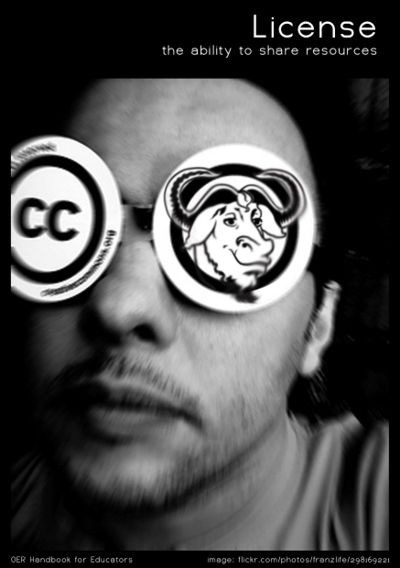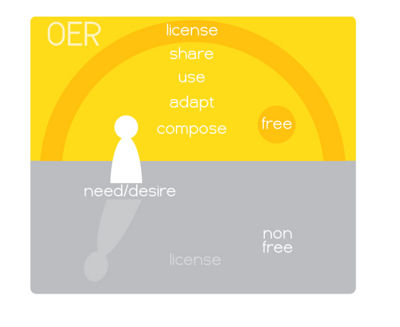License
| [▲]OER Handbook for educators | |
|---|---|
| Contents | | Introduction | Find | Compose | Adapt | Use | Share | License | Conclusion | Appendices |
- Copyright Clearance
- License Compatibility
- Creative Commons
- Adding a Creative Commons License
- GFDL
- Which License Should I Choose?
- Perspectives
Many educators assume that when they put content on the Internet, they are doing so to share with others. While that may be true, unless materials are licensed under open licenses (such as those described in this section), educators' freedom to share these resources is legally is restricted. Fair use applies, but as discussed earlier, sometimes that isn't enough. Perhaps the greatest gain to the OER movement would be if the huge number of educational resources already on the Internet were open licensed. Most educators are very willing to share. If all of the teacher-created web pages, lesson plans, handouts, and multimedia presentations already on the Internet were open licensed, the world of OER would increase by several-fold. To do this, all you need to do is add an open license to your work. You can use the "License Your Work" tool[1] provided on the Creative Commons site, which will also ensure that your work gets listed in OER search engines. For print material, you should display the license along with a link to the legal code (ex: http://creativecommons.org/licenses/by/3.0/us/ ; see "Adding a Creative Commons license" for more information).
The legal aspects of an OER project can be daunting. Excellent resources exist online, and there are people willing to help with your questions, but the best solution is a local expert who you can rely on. If your institution has a legal department, ask for a consultation.
Copyright law varies from country to country, but it generally provides legal protection - over a limited period of time - for original works. It does not matter if these works are published or not, both are protected.
Copyright reserves certain rights for the copyright holder, while others need to ask permission to do any of the following:
- Create derivative works from the original work
- Distribute originals or copies of the work
- Publicly display or perform the work.
In the US, once the copyright period is over, these limitations fall away (Cornell's Copyright Information Center[2] has more information). After the limitations have expired, the work is said to be 'in the public domain.' A work in the public domain can be used without the author's permission as well as modified to suit whatever purpose you would like.
Additionally, certain exemptions to copyright protection are set out in laws or regulation, referred to as "fair use" or "fair dealing" in some countries. What constitutes fair use varies from country to country.
As mentioned in the introduction, legal issues prevent the wide-spread sharing of educational resources without the use of an 'open' license. This section will describe some of the most popular open licenses including Creative Commons and the GNU Free Documentation License (GFDL).
Notes
- Jump up ↑ http://creativecommons.org/license/
- Jump up ↑ http://www.copyright.cornell.edu/public_domain/
Sources
Schmidt, P. (2007, November). "6.3 Licensing Guidelines." UNESCO OER toolkit. WikiEducator. Retrieved March 21, 2008, from http://www.wikieducator.org/UNESCO_OER_Toolkit_Draft#Licensing_guidelines

